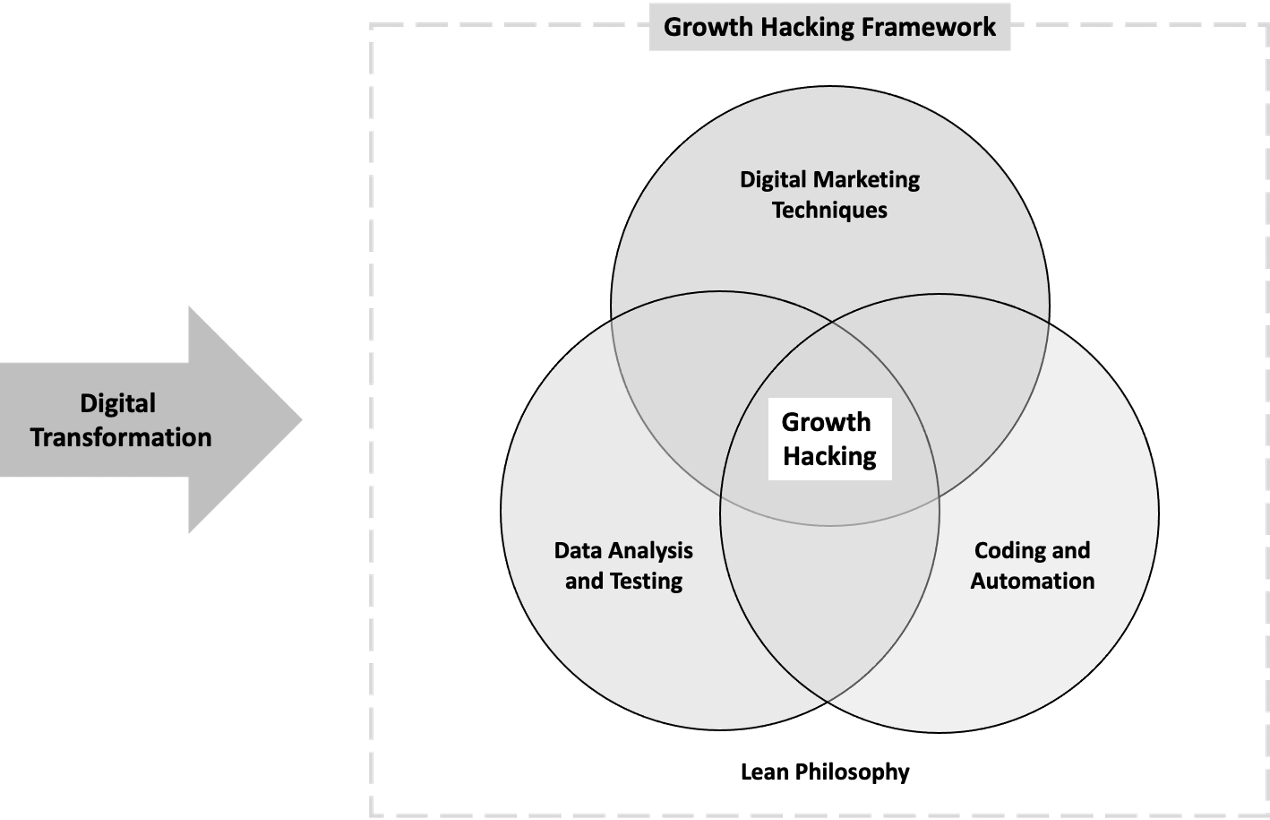
This research article by Rusheé Ramchuran explains The Lean Startup Methodology, and explores digital transformation as a catalyst for growth hacking, with real-world examples.
High and sustainable growth companies (companies with at least a 20% annual revenue growth average over three years) have generated significant interest in recent times – largely due to the fact that these companies drive new innovation in the world, contribute towards high skilled job creation within the economy and are driven to scale-up over the long-term to deliver significant value to society (as opposed to focusing on short-term profits or exits) (Reypens et al, 2020).
Such companies have leveraged digital technologies and growth strategies in innovative ways to achieve sustainable growth in a short span of time and deliver products/services that have forever changed the landscape of global industries. These successful growth strategies (also known as growth hacks) are the product of collective efforts from engineering, marketing, leadership, design, and product management (Keating, 2021).
Most high growth early-stage companies differentiate themselves by being recognised as developers of new innovations in their industry, and the world (Reypens et al, 2020). According to an EIBIS Start-up and Scale-up Survey in 2019, with 1,100+ firms sampled from Crunchbase – 65% of high growth companies reported that the most innovative aspect about their business is a new world innovation. Similarly, Wei (2019) concludes that companies which innovate new technologies will have more development opportunities and experience higher growth rates. However, technological innovation also requires more time, skills and capital investment to achieve rapid growth – which many early-stage companies do not possess. Instead, business model innovation that effectively leverages digital channels and strategies can also achieve growth in a more cost-effective and sustainable approach (Wei, 2019).
This business model innovation has led to the foundation of what is known today as “growth hacking”. The term was coined in 2010 by Sean Ellis, who characterised a growth hacker as “a person whose true north is growth” (Ellis, 2010). The process of growth hacking in companies is enabled by digital transformation and is dependent on rapid experimentation and the lean startup methodology (Ellis and Brown, 2017).
1. The Lean Startup Methodology
Previous methodologies to starting a business involved developing a business plan, pitching it to investors, assembling a team, introducing a product, and selling as aggressively as possible. This approach resulted in up to 75% of US venture-backed startup companies failing within their first three years, according to Harvard Business School professor Shikar Ghosh (Blank, 2013).
The lean startup methodology was introduced by Eric Ries to reduce the risks of failure in early-stage companies. This approach prioritises experimentation over extensive planning, customer feedback over intuition, and iterative design over large upfront development. The lean startup method helps companies to validate product and market fit at the early stages of the product lifecycle before dedicating significant resources for further development and growth (Kenton, 2019).
Despite being in existence for only a few years, it’s key concepts—such as “minimum viable product” and “pivoting” have been widely adopted by global startups as a framework for rapid go-to-market strategy and sustainable growth.
However, the lean startup model also differentiates itself in the hiring of new employees that can learn, adapt and work quickly as opposed to traditional business models that hire based on experience and ability (Blank, 2013). The benefit of this approach is that companies can minimise the initial costs on human resources, and develop specific skills required to scale product and revenue growth for the business model. However, the short-term savings in human capital will develop into long-term investment in skill training and development. To effectively develop a growth strategy, a certain degree of technical, product and market-related knowledge is required within a team – along with synergistic efforts on implementation. Yet, depending on the company’s industry – highly specialised skills can demand higher market salaries (such as big data and cloud computing, artificial intelligence, data analysis, mobile app development and more), even at early stages of business (Slattery, 2019).
Similarly, the lean startup model differentiates itself from traditional business models in its financial reporting metrics. Traditional business models prioritise income statements, balance sheets and cash flow statements as measures of growth, whereas the lean startup model prioritises customer acquisition and retention, churn rate, customer lifetime value and product virality as growth metrics (Kenton, 2019). This method of measurement helps companies to better align product and business strategy to meet customer and market demands – driving sustainable growth over the long term. By focusing on metrics like customer acquisition and retention, and customer lifetime value, companies can invest more resources to understand customer needs and how to solve them – and even predict changing customer behaviour and preferences to adapt the product and business strategy in time to minimise risk of failure.
Ironically, the primary goal of the lean startup model is not for companies to achieve rapid growth in the shortest possible time, but to “reach failure quickly and cheaply” so as to learn and adapt the product and business strategy to achieve sustainable growth over the long term. This process of rapid experimentation and agile product development can result in companies developing new world innovations that solve global industry challenges – such as General Electric who used this method to develop a new battery for use by cell phone operators in developing countries where electricity is unreliable (Kenton, 2019). The lean startup methodology is not only adopted by early-stage companies, but also by larger enterprises such as General Electric, Qualcomm, Intuit, Amazon, LinkedIn, Airbnb, Hubspot and more (Kenton, 2019 and GrowthHackers, 2021).
2. Digital Transformation and The Growth Hacking Framework

Figure 01: The Growth Hacking Framework (Bohnsack and Liesner, 2019)
According to Bohnsack and Liesner (2019) – digital transformation is an important catalyst for growth hacking. With the rate of development of new technologies, digital transformation has become even more imperative for companies today, regardless of their size – however it also presents opportunities as well challenges. For example, the development of smartphones, social media and big data has enabled companies to instantly reach millions of consumers with little to no marginal cost – allowing these companies to scale their growth much faster and at lower costs. In contrast, it also increases competition by lowering barriers of entry for other companies to enter the market and address consumer needs Bohnsack and Liesner (2019).
As depicted in Figure 01, Bohnsack and Liesner’s (2019) Growth Hacking Framework follows the lean startup methodology (also known as the lean philosophy) and is triggered by digital transformation. In this diagram, Growth Hacking is the combination of Digital Marketing Techniques, Data Analysis and Testing as well as Coding and Automation.
2.1. Digital Marketing Techniques
The first component of growth hacking involves marketing, or more specifically, digital marketing – which revolves around product or service marketing through digital and online channels (includes email; website; search engines; social media; digital advertising and mobile apps) (Kannan and Li, 2017).
Digital marketing focuses on communication by creating awareness and acquiring new customer, hence it usually creates touchpoints at the beginning of the customer lifecycle. Bohnsack and Liesner (2019) further identify that growth hacking has touchpoints throughout the customer lifecycle similar to the traditional marketing model of 4Ps (product, price, promotion and place) – making growth hacking a “digital return to the classical marketing values”.
However, many companies have successfully implemented growth hacks within digital marketing techniques that have seen exponential return in the form of new customer acquisition.

Figure 02: Screenshot of the Dropbox Referral Growth Hack (Mengoulis, 2019)
An example of a successful implementation of a growth hack that includes digital marketing techniques is Dropbox. The cloud storage software as a service (SaaS) company implemented a referral program that encouraged existing users to invite friends and rewarding both parties with extra storage as a result of a successful sign up. As shown in Figure 02, Dropbox allowed users to send direct email invitations to friends through the platform and included a direct share button link to social platforms like Facebook, and a copy link button to share on websites or virtually any online channel. By opening the digital marketing channels to which the referral can be shared and addressing the customer need for additional storage – Dropbox was able to grow by 3900% from September 2008 (100k users) to December 2009 (4M+ users).

Figure 03: Screenshot of the Bio Extratus’ Social Content & Users (Nunes, 2020)
Another effective example of growth hacking using digital marketing techniques is the case of Bio Extratus, a company that produces and sells natural cosmetics with a focus on being environmentally conscious. The company used effective content marketing as fuel to drive growth through digitals channels, after realising that many competitors focused on creating content around products instead of consumers (Nunes, 2020). Bio Extratus developed customer-centric content that focused on core values and concerns of their target audience, and used a mix of influencers, social network distribution, videos, tutorials and blog posts to reach their consumers with the primary goal of educating and informing (see Figure 03). This approach proved effective as the content was not only valued by users but also by search engines, which indexed and ranked Bio Extratus’ quality content high in search engine results – driving organic web sessions up by 400% in one year from 530k+ to 4.3M+ (Nunes, 2020). This led to search engines becoming the main source of organic traffic for the company and effectively reduced the overall acquisition cost of new customers by 42% (Nunes, 2020).
What is clear in both Dropbox and Bio Extratus is that these companies understood their target audience needs and developed a growth hack that would not only solve the need through digital channels but create additional benefits for users in the process.
2.2. Data Analysis and Testing
Customer preferences and behaviour are constantly changing as a result of a number of factors that influence purchasing decisions (from demographics to culture trends and individualism), which means companies need to better understand their customers in order predict the change in preferences and behaviour, or even influence the change to align with a product or business strategy. Understanding customer preferences and behaviour, without having to ask customers, can create a competitive advantage (Bohnsack and Liesner, 2019). With the rise of big data and advancement in the Internet of Things, companies today can instantly collect and access customer-specific data and leverage technologies that translate the data into actions that drive better decision-making (Bohnsack and Liesner, 2019).
As identified, the lean startup methodology involves a process of rapid experimentation to quickly establish product and market fit (Kenton, 2019). These series of experiments and testing requires data to be collected in each scenario and translated into actionable analytics that help companies to make more informed business decisions. The more experiments that a company can run, the more data is collected from customers, creating a significant learning and analysis opportunity for the company to better understand and predict customer preferences and behaviour.

Figure 04: Screenshot of an A/B Test conducted on Amazon’s Platform (Leone, 2021)
Amazon is one of the highest valued companies in the world, with a valuation of over US$1 trillion in 2020. Founder, Jeff Bezos, attributes the success of Amazon as a function of how many experiments the company runs per year, per month, per week and per day (Leone, 2021). Amazon effectively runs 10k+ A/B tests annually on its e-commerce platform to better understand customer preferences and enhance the customer experience of shopping online with Amazon. The types of experiments conducted span across website changes, adding new features and design changes, placement of elements, updating algorithms for recommendations, changing search relevance rankings, making strategic partnerships and introducing new services (see Figure 04). Even the smallest changes can have significant impact when implemented correctly. For example, one of Amazon’s tests revealed that moving credit card offers from the home page to the shopping cart boosted Amazon’s profits by millions of dollars (Leone, 2021).

Figure 05: Screenshots of the Early Tinder Dating App and Gamification Features (Brown, 2015)
Tinder is another example of data analysis and testing in a growth hacking strategy that focused on narrowing down the target audience and gamifying the user experience. The online dating mobile app introduced itself to college students between the ages of 18 and 25 on campuses in the United States, with a requirement to download the app to be granted entry into a social party (Brown, 2015a). The app was free to download creating a low barrier to entry for college students. Once the app was downloaded on the student’s phone – the location-based settings allowed the user to find others in their location who were open to dating, and pioneered the ‘swipe left for no or swipe right for yes’ and gamification feature that provided the same sense of instinct and reward the real-life dating world (see Figure 05). With its simplicity – word of mouth had spread creating a network effect, and in just two years – the company’s user base had grown to 10M+ (Brown, 2015a).
For companies looking to implement a growth hack strategy, the process of data analysis and continuous testing is pivotal to understanding customer preferences and aligning a product and market strategy for success. According to Jeff Bezos, companies should look at maximising the number of experiments that can be conducted in a given time period, reduce the cost of running the experiments, and develop infrastructure that will enable this (Leone, 2021). However, companies need to ensure that any personal user data that collected in these experiments is done so legally, with consent from the user for use in analysis and product or business improvements.
2.3. Coding and Automation
Bohnsack and Liesner (2019) identify the third component of a growth hacking strategy as coding and automation, which involves creating or programming code and automating touchpoints with the user and product to make the process more efficient. In prior years, the technical capability and knowledge of coding would have been necessary to build an automated growth hacking strategy – however with the rise of the no code revolution, more employees in non-technical departments can also learn to build advanced workflows using software that communicates with each other without having to write a single line of code (Pot, 2020). This shift reinforces the hiring approach in the lean startup methodology, as complex and technical solutions can now be learnt, developed and implemented by non-technical users – making growth hacking strategies accessible to more companies. Furthermore, the rise of artificial intelligence already has, and will continue to, enhance the user experience of customers digitally with automation and personalisation that creates a tailored and one-to-one engagement.

Figure 06: Screenshot of an Airbnb listing on Craigslist in 2011 (Brown, 2015)
Airbnb, the flexible accommodation booking app, is famously known for its growth hacking strategy, albeit one that involves technical knowledge and coding expertise. In 2010, the Airbnb team discovered that the majority of their target audience, being people who were looking for alternative and affordable accommodation, searched for these listing on Craigslist – a popular classifieds website at the time (Brown, 2015b). Craigslist had a significant user base over Airbnb. Airbnb built an automated bot that enabled its users to create a listing, copy it directly on to Craigslist, verify the information and and publish it (see Figure 06). This allowed Airbnb to reach Craigslist’s huge user base, and when the user clicks on the listing – it redirects them to the Airbnb website listing to complete the booking (Brown, 2015b). Once Craigslist had discovered the loophole, they had updated their platform to prevent this from happening further – however, by then the Airbnb user base had grown substantially. While this growth hack was achievable in 2010, it becomes more complex to implement a similar hack in today’s digital world due to advances in technology, security and platform architecture. Instead, a key takeaway from this growth hack is the ability to integrate two or more platforms that can automate and share data. For example, platforms like Zapier and IFTTT allow users and companies to connect independent platforms and apps by sharing data through secure APIs. This allows companies to build complex automation workflows that syncs data across multiple platforms without the requirement of coding knowledge or expertise. As mentioned, this makes growth hacking strategies more accessible to companies at lower skill and labour costs.
3. Challenges of Growth Hacking Strategies
3.1. Skilled Labour Requirement
While growth hacking requires a collaborative effort across multiple departments and disciplines, it also requires a hybrid or multi-skilled leader, marketer or engineer who can bridge the knowledge gap and drive both the vision and execution of the strategy (Bohnsack and Liesner, 2019). Highly skilled growth hackers are difficult to find since the concept and demand of such professionals has existed for a short span of time. It may be a better investment for companies to train and develop growth hacking skills and expertise within their team in order to minimise costs, reduce time to product or market fit and develop specialised strategies based on the specific business model.
3.2. Time, Product and Market Relevance
Being first to market is an important factor and significant achievement for any type of product or company, however once the barrier has been broken – the risk of competition increases particularly if product-market fit has been validated. For example, Uber may have been the first ride-sharing app introduced in 2009 – but following from the initial product and market validation, similar products and companies (such as Lyft) entered the market to compete for market share (Sui, 2017). As established, a growth hack strategy such as that implemented by Airbnb may have been effective in 2010 – however a similar strategy may not be valid or executable in today’s digital world. It should also be considered that a product which existed, and achieved popularity, in previous years may not exist today or in the future due to changing customer preferences, developments of new technologies or better alternatives – for example MySpace (Coronel, 2021).
3.3. Cost of Exponential Growth
Growth hacking strategies can lead to rapid growth in short time frame, but companies will need to be able to scale their operations accordingly to meet the newly generated demand. Failure to deliver on products or services as growth rates increase can have a counter-effect on the objectives of the growth strategy implemented. Furthermore, as the success of the growth hack strategy scales, so too will the cost of growth. For example, PayPal’s growth hack strategy involved a referral system that rewarded both the user and their friend with US$10 each for signing up since the lifetime value of the user was calculated to be US$20. This strategy helped PayPal to grow their user base daily by 10% to achieve 100 million users, yet the total cost of this referral system was estimated to be US$60 million (Hall, 2019).
Conclusion
Based on Bohnsack and Liesner’s (2019) Growth Hacking Framework, the lean philosophy creates an effective business model for companies to develop growth hacking strategies through a combination of digital marketing techniques, data analysis and testing and coding and automation. The primary objective of growth hacking is to reach failure quickly and cheaply so as to learn and adapt the product and business strategy to achieve sustainable growth over the long term. However, companies should consider the costs of developing and implementing such strategies, the viability and scalability of the strategy within the business ecosystem, as well as finding (or training) the right team for successful execution – since growth hacks evolve with new technologies and times, and strategies that may have worked in past may not prove as effective today.
References
ArabianBusiness.com. 2020. Middle East ‘ripe’ for new unicorn start-up. [online] Available at: https://www.arabianbusiness.com/startup/449506-middle-east-ripe-for-new-unicorn-start-up [Accessed 6 March 2021].
Blank, S. (2013) Why the Lean Start-Up Changes Everything [online] Harvard Business Review. Available at: https://hbr.org/2013/05/why-the-lean-start-up-changes-everything [Accessed 29 March 2021].
Bohnsack, R. and Liesner, M. (2019) What the Hack? A Growth Hacking Taxonomy and Practical Implications of Growth Hacking for Firms. [online] Available at: https://www.researchgate.net/publication/332698355_What_the_Hack_A_Growth_Hacking_Taxonomy_and_Practical_Implications_of_Growth_Hacking_for_Firms [Accessed 31 March 2021].
Brown, M. (2015a) What Ignited Tinder’s Explosive Growth?. [online] GrowthHackers. Available at: https://growthhackers.com/growth-studies/what-ignited-tinders-explosive-growth [Accessed 2 April 2021].
Brown, M. (2015b) Airbnb: The Growth Story You Didn’t Know. [online] GrowthHackers. Available at: https://growthhackers.com/growth-studies/airbnb [Accessed 3 April 2021].
Casnici C.V.C. (2021) The Rise of Unicorn Companies: A Magical Growth?. In: Park S.H., Gonzalez-Perez M.A., Floriani D.E. (eds) The Palgrave Handbook of Corporate Sustainability in the Digital Era. Palgrave Macmillan, Cham. https://doi.org/10.1007/978-3-030-42412-1_29 [Accessed 3 March 2021].
Cole, B. (2019) When Does A Start-Up Become A Scale-Up?. [online] Forbes. Available at: https://www.forbes.com/sites/biancamillercole/2019/02/27/when-does-a-start-up-become-a-scale-up/?sh=1faa4b32636d [Accessed 6 March 2021].
Coronel, J. (2021) Does Myspace Still Exist? Say Hi to its Carbon-Copy Spacehey!. [online] Tech Times. Available at: https://www.techtimes.com/articles/256907/20210210/myspace-still-exist-hi-carbon-copy-spacehey.htm [Accessed 3 April 2021].
Ellis, S. (2010) Find a Growth Hacker for your Startup [online] Startup Marketing. Available at: https://www.startup-marketing.com/where-are-all-the-growth-hackers/ [Accessed 28 March 2021].
Ellis, S. and Brown, M. (2017) Hacking Growth: How Today’s Fastest Growing Companies Drive Breakout Success (1st ed.) London, UK, Virgin Books.
GrowthHackers (2021) Original Growth Studies on GrowthHackers – Premier Growth Community. [online] Growthhackers.com. Available at: https://growthhackers.com/growth-studies [Accessed 30 March 2021].
Hall, S. (2019) 23 Proven Growth Hacking Examples You Can Steal to Gain Traction. [online] OptinMonster. Available at: https://optinmonster.com/growth-hacking-examples/ [Accessed 3 April 2021].
Kannan, P.K. and Li, H. (2017) Digital Marketing: A framework, review and research agenda. [online] International Journal of Research in Marketing. 34[1], 22-45
Keating, E. (2021) 21 Innovative Growth Strategies used by Airbnb, Etsy, Slack, Twitter, and more. [online] Appcues.com. Available at: https://www.appcues.com/blog/growth-strategies [Accessed 28 March 2021].
Kenton, W. (2019). Lean Startup. [online] Investopedia. Available at: https://www.investopedia.com/terms/l/lean-startup.asp [Accessed 30 March 2021].
Leone, N. (2021) How Amazon Built Its Growth Ecosystem. [online] GrowthHackers. Available at: https://growthhackers.com/growth-studies/how-amazon-built-its-growth-ecosystem [Accessed 2 April 2021].
Mengoulis, A. (2019). Dropbox grew 3900% with a simple referral program. Here’s how! | Inside Viral Loops. [online] Inside Viral Loops. Available at: https://viral-loops.com/blog/dropbox-grew-3900-simple-referral-program/ [Accessed 1 April 2021].
Miller, D., Costa, E., Haynes, N., McDonald, T., Nicolescu, R. and Sinanan, J. (2016) How the World Changed Social Media. [online] Library.oapen.org. Available at: https://library.oapen.org/viewer/web/viewer.html?file=/bitstream/handle/20.500.12657/32834/604151.pdf?sequence=1&isAllowed=y [Accessed 5 March 2021].
Monteiro, Guilherme Fowler A. (2019). High-growth firms and scale-ups: a review and research agenda. RAUSP Management Journal, 54(1), 96-111. Epub May 02, 2019.https://doi.org/10.1108/rausp-03-2018-0004 [Accessed 3 March 2021].
Nunes, G. (2020) Bio Extratus – Beyond a Beauty Blog. [online] GrowthHackers. Available at: https://growthhackers.com/growth-studies/bio-extratus-beyond-a-beauty-blog [Accessed 1 April 2021].
Pot, J. (2020) What is no code and why should you care? | Zapier. [online] Zapier.com. Available at: https://zapier.com/blog/what-is-no-code/ [Accessed 2 April 2021].
Reypens, C., Delanote, J. and Rückert, D. (2020) From starting to scaling: How to foster startup growth in Europe. [online] Library.oapen.org. Available at: https://library.oapen.org/viewer/web/viewer.html?file=/bitstream/handle/20.500.12657/43435/external_content.pdf?sequence=1&isAllowed=y [Accessed 3 March 2021].
Rudden, J. (2020) Unicorns: number by region 2020 | Statista. [online] Statista. Available at: https://www.statista.com/statistics/1092626/number-of-unicorns-in-the-world-by-region/ [Accessed 7 March 2021].
Siu, E. (2017) 10 Lessons Startups Can Learn from Uber’s Growth. [online] Single Grain. Available at: https://www.singlegrain.com/blog-posts/business/10-lessons-startups-can-learn-ubers-growth/ [Accessed 3 April 2021].
Slattery, A. (2019) 10 High-Income, In-Demand Skills to Get a New Job (and Better Pay). [online] InHerSight. Available at: https://www.inhersight.com/blog/insight-commentary/high-income-skills-employers-want [Accessed 30 March 2021].
Szatylowicz, K. (2019) 5 Ways Retail AI Will Influence Consumer Behavior. [online] Blog.crobox.com. Available at: https://blog.crobox.com/article/ai-consumer-behavior [Accessed 2 April 2021].
Wei, X. (2019) Unicorn Companies in China. [online] Webthesis.biblio.polito.it. Available at: https://webthesis.biblio.polito.it/11460/1/tesi.pdf [Accessed 5 March 2021].
About The Author

RUSHEÉ RAMCHURAN | Chief Marketing Officer
Rusheé has more than 10 years of experience in digital marketing strategy, development and implementation across various verticals and organizations. He has held several leadership roles in marketing – with a focus on leveraging marketing data to drive better business decisions. Rusheé manages and drives the Edgematics Partner ecosystem, through collaborative engagements and focused go-to-market strategies. He brings both business acumen and creative perspective to client, partner and project engagements.
Image: Edgematics Technologies LLC.


